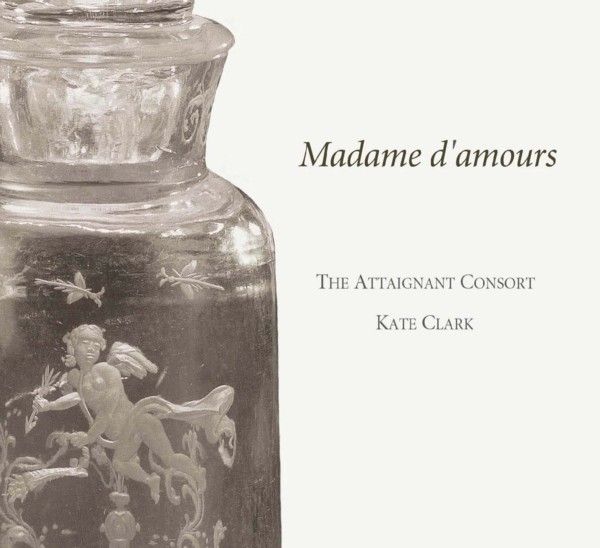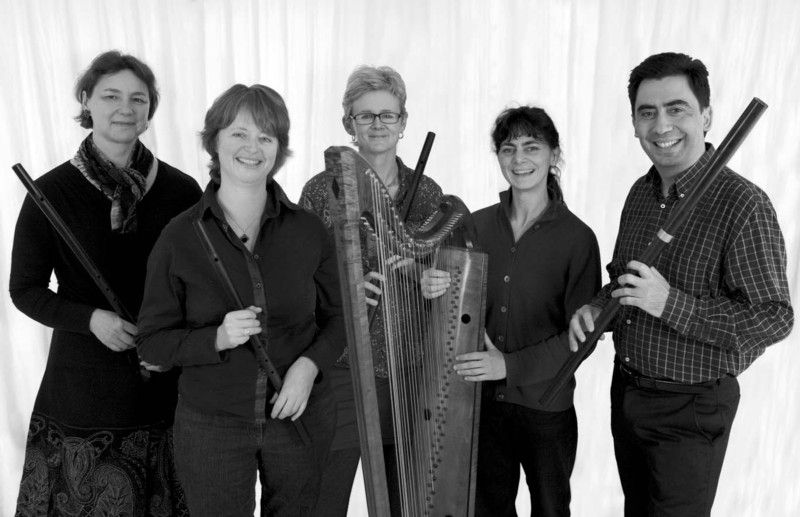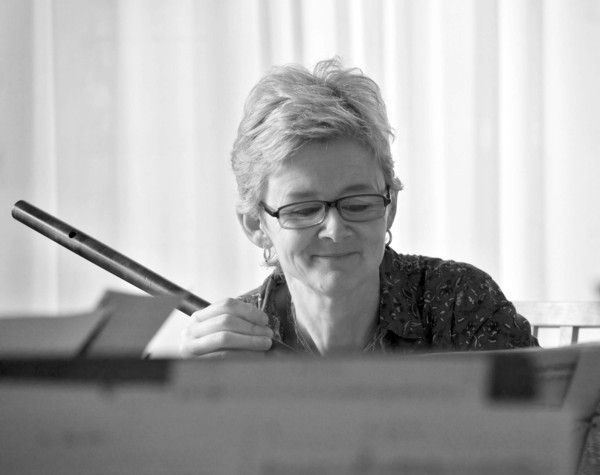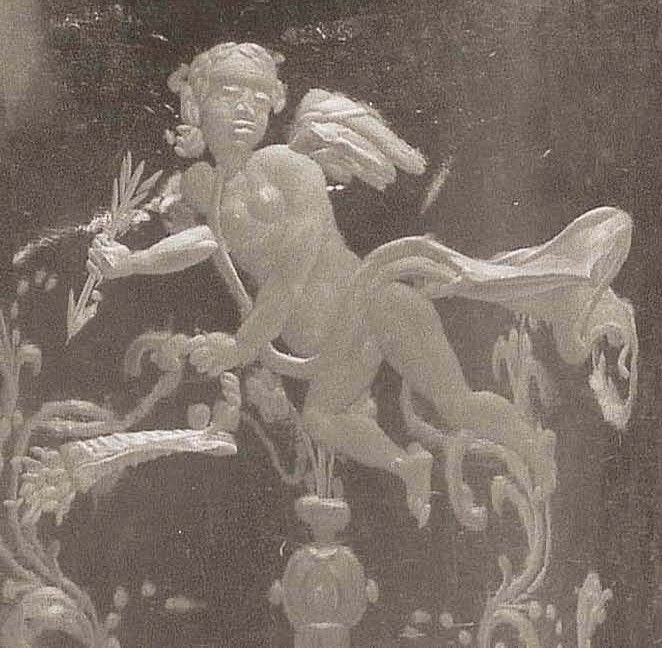Madame d'amours. Music for Renaissance Flute Consort
The Attaignant Consort

medieval.org
Ramée RAM 0706
2007
1. Madame d'amours [1:32]
consort à 4
2. The Duke of Sommersettes Dompe [2:03]
lute solo
3. Robert FAYRFAX (1464—1521). Farewell my joy
[2:09]
flute and lute
4. My Lady Careys Dompe [1:58]
harp solo
5. Henry VIII (1491—1547). Pastyme with good companye
[1:50]
consort à 4, lute and harp
—·—
JOSQUIN (1440—1521)
6. In pace ~ Que vous madame [4:17]
consort à 3
7. Mille regretz [1:37]
consort à 4 and harp
8. Luys de NARVÁEZ (?—1549). La Canción del
Emperador (Mille regretz) [2:35]
lute solo
Heinrich ISAAC (c. 1440—1517)
9. Güretzsch ~ Si dormiero [3:45]
consort à 3
10. La my [2:21]
consort à 4
—·—
11. Arnolt SCHLICK (c. 1460— after 1521). Mein M. ich hab
[1:49]
flute and lute
12. Paul HOFHAIMER (1459—1537). Ach Lieb mit Leid
[1:35]
consort à 4
13. Ludwig SENFL (1486—1542). Carmen [0:52]
consort à 4
14. Hans JUDENKÜNIG (c. 1460—1526). Ein seer guter
Organistischer Preambel [3:05]
lute solo
15. Georg FORSTER (1510—1588). Ich habs gewagt
[1:20]
consort à 4
16. Das Jägerhorn [0:54]
consort à 3
—·—
17. Jacob OBRECHT (1456—1505). Qui cum Patre et Filio
[1:54]
2 bass flutes
18. Orlando di LASSO (1530—1594). Beatus Vir [1:14]
2 tenor flutes
19. Tomás Luis de VICTORIA (1548—1611). Tenebrae
factae sunt [4:19]
consort à 4 – 2 tenor and 2 bass flutes, harp and lute
—·—
Claudin de SERMISY (1490—1562)
20. Tant que vivray [1:51]
consort à 4 and harp
21. Au pres de vous [2:24]
consort à 4
22. Nicolas GOMBERT (1495—1560). Amours,amours
[2:03]
consort à 4
23. Pierre SANDRIN (1538—1560). Doulce memoire
[3:43]
consort à 4, harp and lute — divisions by Diego ORTIZ
(1510—1570)
24. Jean-Paul PALADIN (?— 1565). Le content est riche
[2:20]
harp solo
25. Jacobus CLEMENS non Papa (1510—1555). Frais et Gaillard
[3:31]
flute and harp — divisions by Giovanni BASSANO
(1560—1617)
26. Claudin de SERMISY. Au joly bois [3:22]
consort à 4 – 2 tenor and 2 bass flutes, harp and lute
27. Clément JANEQUIN (1485—1558). Le rossignol. En
escoutant [1:45]
consort à 4
—·—
28. Alfonso FERRABOSCO (1543—1588). Fantasia [3:25]
lute solo
29. Cipriano de RORE (1515—1565). Anchor che col partire
[3:57]
flute and lute — divisions by Riccardo ROGNONI (c.
1550—1620)
30. Ricercada [1:55]
harp solo
—·—
John DOWLAND (1563—1626)
31. Pavan Lachrimae [4:37]
flute and lute — divisions by Jacob van EYCK (c.
1589—1657)
32. Praise blindnesse eies [2:16]
consort à 4 and lute
33. Fine knacks for ladies [1:42]
consort à 4 and lute

THE ATTAIGNANT CONSORT
KATE CLARK direction, flute
FRÉDÉRIQUE CHAUVET flute
MARION MOONEN flute
MARCELLO GATTI flute
THE ATTAIGNANT CONSORT
gratefully acknowledges the magnificent
collaboration, for this recording, of
MATHIEU LANGLOIS flute
MARTA GRAZIOLINO harp
NIGEL NORTH lute
CONSORT À 4:
Kate Clark, descant—Frédérique Chauvet,
alto—Marion Moonen, tenor—Marcello Gatti, bass
(except for 19 and 26:
Kate Clark, tenor—Marion Moonen, tenor—Mathieu Langlois,
bass—Marcello Gatti, bass)
CONSORT À 3:
Kate Clark, descant—Marion Moonen, tenor—Marcello Gatti,
bass
BASS FLUTES IN 17: Marcello Gatti, Mathieu Langlois
TENOR FLUTES IN 18: Kate Clark, Marcello Gatti
All flutes: Giovanni Tardino, Rome 2000, after anonymous 16th-century
builder (collection in the Academica
Filarmonica, Verona)
Arpa doppia, Enzo Laurenti, Bologna 1999, after 17th-century Italian
instrument
Eight-course renaissance lute, Paul Thomson, Bristol 1999, after
Vendelio Venere, c. 1580
Recorded in May 2007 at the church of Notre-Dame de l'Assomption,
Basse-Bodeux, Belgium
Recording, artistic direction, editing & production: Rainer Arndt
Graphic concept: Laurence Drevard
Design & layout: Rainer Arndt, Catherine Meeùs
Cover: Flagon ornamented with a winged Cupid and motives
»à la Bérain«,
France, 17th century
Photos: © bpk/RMN/Musée du Louvre/Jean-Gilles Berizzi
(cover)
© Laura Lombardi (booklet)
Translations: Rainer Arndt (German)
Frédérique Chauvet, Catherine Meeùs (French)

MUSIC FOR RENAISSANCE FLUTE CONSORT
From the early renaissance to the present day, the slender, side-blown
flute of the Western art music tradition has undergone a series of
transformations. Its interior contour has changed from being
cylindrical to being conical and back again, it has gained and lost
various keys, and the mechanisms for operating them have been
successively refined. While woods of various kinds and colours have for
centuries been most favoured for its construction, the flute was also
given form in glass, crystal and ivory, surviving in the mid-nineteenth
century a truly remarkable transformation into a shimmering pipe of
precious metal. Today, an enduring preference for the sound of wooden
flutes is reasserting itself, as many players of the
»modern« flute redesigned by Theobald Böhm are turning
again to wooden-bodied flutes, silver being reserved for the slide and
key mechanisms only.
The flute of each period had its own distinctive sound, peculiar to the
musical epoch in which it flourished. The elegant, keyless, cylindrical
flute of the sixteenth century had a reedy, penetrating sound, closer
to the cornetto than to any other wind instrument of the day. It had an
impressive range of two and a half octaves and an evenness of tone
quality that would not be matched again until the nineteenth century.
Its dynamic flexibility and responsiveness to subtleties of
articulation endowed it with a vocal quality. And, for all its outward
simplicity, it was capable of a startling virtuosity. Together with its
bass and descant variants, it played a full part in that distinctive
sixteenth-century musical phenomenon: the instrumental consort.
In this recording we focus on repertoire for the renaissance flute
consort, almost all of which was originally vocal music. We have
included a number of purely instrumental pieces, Heinrich Isaac's La
my, Ludwig Senfl's Carmen, and the Anonymous Jägerhorn
which show the agility of which the consort was capable. There are
several pieces for one flute with lute or harp in which the flute's
role is closer to that of the singer-poet or narrator, conveying the
words of a song in a polyphonic context in which the other voices are
carried by the plucked instrument as in Robert Fayrfax's Farewell
my joy and Arnolt Schlick's Mein M. ich hab.
Some of the solo pieces are presented in highly ornamented versions,
known as »divisions« in which little melodic flourishes,
each with a rhythmic life of its own, have replaced (or
»divided« up) the longer notes of the original. Divisions
gave new life, perhaps a contemporary flavour, to popular melodies from
previous generations. Riccardo Rognoni's divisions on Cipriano de
Rore's Anchor che col partire, and Jacob Van Eyck's on John
Dowland's Pavan Lachrimae are two famous and beautiful examples.
Other pieces present diminutions in several parts simultaneously within
the consort context. This practice, well documented in
sixteenth-century sources, called for extra skill, generally requiring
that the diminutions be written down for each part rather than
improvised in performance, so as to avoid undesirable clashes or
dissonances between parts (though surprising dissonances are not
entirely absent from some of the most beautiful composed divisions of
the period). Diego Ortiz's version of Pierre Sandrin's Doulce
memoire provides diminutions for both descant and bass voices
simultaneously. For Claudin de Sermisy's Au joly bois I have
composed divisions for all four voices. Other incidental divisions in
the recording have been improvised in the performance.
Finally we present a number of pieces for lute and harp solo, the two
»classic« polyphonic instruments of the renaissance world
of bas or soft instruments. The association of flute with
plucked instruments may be traced far back in the history of both
Western and Eastern musical traditions. The juxtaposition of the
melancholy lyricism of the one with the quietly stunning articulacy and
eloquence of the others, has captivated musicians and listeners for
centuries.
THE AGE OF THE FLUTE CONSORT
By the year 1600, hardly a musician alive could remember when the
practice of playing in consorts had begun. The word had come to denote
a group of musicians playing upon a family of like instruments
– or the family of instruments itself – made in several
different sizes so as to reproduce the registers of the ensemble of
human voices: bass, tenor, alto and descant. It was no less than the
instrumental embodiment of the vocal ensemble. By then a
long-established feature of the musical landscape in English, German,
French and Italian-speaking lands, it was destined to persist well into
the seventeenth century, and to have consequences for musical practice
far further into the future.
Yet the very idea of such a consort once swept across Europe like a
scented breeze intimating the coming of spring. It brought the promise
of new possibilities of expression and participation in music making.
The ascendancy of the consort principle went hand in hand with the
spread of polyphonic music from the sacred into the secular realm, and
the consort was uniquely placed to exploit the rise of imitative
counterpoint as the dominant compositional model, in which all voices
played an equally important role. Indeed, it is hard not to see in the
consort principle, with all its various implications for communal
music-making, both a product and an instrument of humanist influence.
In the eyes of humanists, human endeavour attained a new, enhanced
status. In music, secular forms moved into a new relationship with
sacred ones to which they had formally been considered subordinate. A
basic education in music and private music making for devotional or
recreational purposes were considered to be good for individual
morality. At the same time, the growing market of players wishing to
play in consort in the early sixteenth century was both beneficiary and
patron of a revolutionary new industry: music-printing.
The transverse flute was not among the first instruments to be adapted
for consort use. However, within the first three decades of the
sixteenth century the practice of playing transverse flutes in consort
had taken hold in Western Europe. A comparison of the earliest treatise
documenting the existence of the transverse flute (Sebastian Virdung,
Musica Getutscht, 1511) with treatises by later sixteenth-century
authors helps to locate the emergence of the transverse flute consort,
in German-speaking areas at least, somewhere between 1511 and 1529.
Virdung's little page illustrating mouth-blown wind instruments
presents two sizes of shawm (the longer is called a Bombardt),
and three sizes of recorder, but shows only one Zwerchpfeiff or
transverse flute. In 1529, by contrast, Martin Agricola's Musica
Instrumentalis Deudsch, presented drawings and fingering charts for
a whole consort of flutes. His charts clearly refer to three sizes of
flute only, and make clear too that the tenor and alto parts were
played upon one single size of flute, the lower part of its range being
used for the tenor part and the upper part for the alto. This accords
with all the other sixteenth-century documents on the use of transverse
flutes. Later in our period, the descant flute appears less often: the
middle length flute (fundamental d') having the largest range and
greatest flexibility, had subsumed the role of the descant, and later
consorts comprised one bass and three »tenors«. Indeed it
was the tenor flute which survived mutation into the solo flute of the
baroque and later periods. During the late eighteenth and nineteenth
centuries it acquired longer foot joints extending its range downward
to c' and even b. In its latest incarnation as an instrument made from
metal (c. 1847) this aspect of its historical construction was not
altered.
In England the flute consort was identified for the first time in a
document dated 10th December 1543, though the names of two of the
flautists mentioned in that document first appear in court records in
1537. In his sleuthful sifting through sixteenth-century English court
records on the trail of the history of the violin, Peter Holman exposed
a picturesque metamorphosis: »It seems that the court rebec
consort was replaced (or was changed into) a flute consort in the
1540s«. Players of soft or indoor instruments were generally
skilled on several different ones. As the rebec became outmoded, those
players assigned to perform on it were given other functions more in
keeping with current musical taste. Certainly, by the death of Henry
VIII in 1547, a vast inventory of flutes had been acquired.
In France we have a delightful moment of illumination in 1533 with
Pierre Attaignant's publication of Vingt et sept chansons musicales
a quatre parties desquelles les plus convenables a la fleuste dallemant
sont signees en la table cy dessoubz escripte par a. et la fleuste a
neuf trous par b. et pour les deux par a b. [...] (Twenty-seven
chansons for four parts, of which those most suitable for playing on
the german flute are marked in the index by the letter 'a', those for
the recorder with the letter 'b' and those suitable for both with the
letters 'ab' [...] – The transverse flute had come to be known
across Europe variously as the »german flute«,
»fleuste d'allemand« or »flauto tedesco«
because of its association with military practice particularly by the
Swiss, but also among other German speaking soldiery). Obviously,
Attaignant's publication was aimed at players participating in an
already existing practice.
THE REPERTOIRE
There are two other developments in mid-renaissance Europe that fuelled
the veritable explosion of interest in playing upon consorts of
instruments: the craze for the French (language) chanson which spread
far beyond the borders of French-speaking Europe, and the invention of
music printing, which made polyphonic repertoire, from Josquin's
generation to the sixteenth-century present, available on a scale never
seen before.
Among the most-favoured secular genres in the sixteenth century, the
chanson occupies a distinguished place by virtue of its enormous and
international popularity, and its profuse representation in manuscript
and early printed collections of instrumental music. Chanson here
refers specifically to polyphonic settings of French verse. These were
set by composers from within and without the French kingdom, notably by
many composers from the Low Countries (and consequently known as
»Franco-Flemish chansons«). It is not surprising then, that
when Ottaviano Petrucci came to produce the first book of printed
polyphonic music, his Harmonice Musices Odhecaton A (Venice,
1501), he devoted it almost entirely to the French chanson. Evidently
he considered this the safest basis from which to proceed on what was
plainly an entrepreneurial adventure: he had invented a technique for
printing music from moveable type, and his work was to change the music
industry for ever. Two further books of chansons followed promptly: Canti
B (1501/2) and Canti C (1503/4), confirming his business
acumen as to the popularity of this particular repertoire.
While Attaignant, aiming at a French-speaking market, printed his part
books with texts, albeit often poorly underlayed, Petrucci printed his
chansons, with very few exceptions, with text incipits only. The most
plausible explanation (though it has not been an uncontested one) for
the wide-spread transmission of secular polyphony in textless versions,
from the second half of the fifteenth century onwards, is that it was
increasingly often played and enjoyed in instrumental versions.
For The Attaignant Consort, the chanson repertoire has been an
immensely fruitful and delightful point of departure, and source of
inspiration, since its inception in 1998. We have constantly returned
to it, after each sortie into other genres and national styles. That
fleeting moment of illumination provided by Attaignant's introduction
to his Vingt et sept chansons, is no more than a momentary
flicker of candle-light in the dimness that still shrouds our present
knowledge of renaissance instrumental performance practice. Yet I am
quite unable to believe that the connection he pointed to between
French chansonnerie and performance by transverse flute consort
reflected only a haphazard circumstance of his immediate surroundings.
For in this repertoire, the renaissance flute seems to encounter no
obstacles whatever in expressing everything the music calls for: the
ranges of the parts, the tonalities in which chansons were most
commonly written, the sentiments expressed in their poetry, and even
the French language itself, seem perfectly suited to this instrument's
natural capacities.
Certainly, for this sixteenth-century chronicler, there was a marriage
– so to speak – between the transverse flute and the French
which simply spoke for itself: »[...] il y avoit une
fleute-traverse, que l'on appelle à grand tort fleuste
d'allemand; car les Français s'en aydent mieulx et plus
musicalement que tout aultre nation; et jamais en Allemaigne n'en fust
joué à quatre parties, comme il se faict ordinairement en
France.« (»there was [playing on] a transverse flute,
which is called, quite erroneously, the German flute; because
the French play it better and more musically than any other nation; and
never in Germany was it played in four parts as it commonly is in
France.«)
There is evidence to suggest that professional musicians aimed to
conjure up in their playing not only the sentiments of the text, but
the inflections of the voice and even the pronunciation of the words as
it would be present in a vocal performance; this was the ideal for
which they strove. Sixteenth-century writers on flute playing give only
scanty indications as to how such an ideal might be attained in
playing, but their comments on how to »lead« each note with
the tongue, or how to nuance expression through a variety of
»double« tonguing techniques are telling enough to the
experienced player. With regard to the ultimate aesthetic goal of such
mastery, it has been illuminated for us by a most articulate
contemporary witness: Silvestro Ganassi, who concludes the introduction
to his famous treatise La Fontegara (1535) as follows:
»You may ask me: How is that possible, [the voice] being
something that can utter every [kind of] speech such that I do not
believe that the flute can ever equal it? And I answer you, that just
as a worthy and masterly painter imitates all things created in nature
by [means of] the variation of colours, so can a wind or string
instrument imitate the utterances made by the human voice; [...] And if
the painter imitates the impressions of nature by means of varied
colours, so the [wind] instrument imitates the expressions of the human
voice by modulation of the force of the breath, and by inflection of
the tongue [offuscation della lingua], with the help of the
teeth [deti*]. And in this respect I have had the experience of
hearing other players render understandable with their sound, the words
of that piece [they are playing], such that one can truly say that this
instrument lacks nothing but the form of the human body itself, just as
one says of a beautiful painting that all it lacks is breath.«
(*There is disagreement among scholars as to whether the teeth or the
fingers are intended by the word deti.)
The poetry of all vocal pieces recorded here is included in the back of
the book so as to put the listener in the position of a
sixteenth-century connaisseur who may glean the spirit, the
gesture, and even the intimate details of the text from the
instrumental performance.
This recording is dedicated with gratitude to Norma Scott and Anne
Smith for their guidance at the two most hazardous moments in my own
formal education as a flautist – the beginning and the end.
Kate Clark




